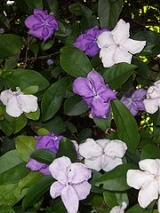
Brunfelsia
Encyclopedia
Brunfelsia is a genus
of about 40 species of neotropical shrubs and small trees.
The leaves are alternate and simple, with shapes generally elliptic to ovate. The flowers are large and tubular, with five broad petals. Typical habitat is light woodland and thickets. Species in cultivation include Brunfelsia americana ("lady of the night") and Brunfelsia pauciflora
. Linnaeus named the genus for early German herbalist Otto Brunfels
(1488-1534). The cultivated plant is commonly called "yesterday, today, and tomorrow" due to its color changes.
Many members of this genus contain toxic and medicinal alkaloid
s. Brunfelsia grandiflora is used by curandero
s in South America as an additive to ayahuasca
and contains the psychoactive chemical scopoletin
. Scopoletin has no N atoms and is not an alkaloid. Brunfelsia hopeana contains the alkaloid hopeanine.
 The observation that the caterpillars of the butterfly genus Thyridia grazed Brunfelsia and also species that then regarded to belong to the scrophulariaceae
The observation that the caterpillars of the butterfly genus Thyridia grazed Brunfelsia and also species that then regarded to belong to the scrophulariaceae
prompted taxonomists to re-evaluate its classification which lead to its being reassigned within this family. This grazing preference was probably related to similarities in chemistry between these plants that in turn were related to their evolutionary ancestory.
Genus
In biology, a genus is a low-level taxonomic rank used in the biological classification of living and fossil organisms, which is an example of definition by genus and differentia...
of about 40 species of neotropical shrubs and small trees.
The leaves are alternate and simple, with shapes generally elliptic to ovate. The flowers are large and tubular, with five broad petals. Typical habitat is light woodland and thickets. Species in cultivation include Brunfelsia americana ("lady of the night") and Brunfelsia pauciflora
Brunfelsia pauciflora
Brunfelsia pauciflora is a species of plant native to the woodlands of Brazil, and cultivated for its flowers. It is most common between central and sub-tropical America, and is also popular in southern Africa, where it is known as the Yesterday, Today and Tomorrow plant...
. Linnaeus named the genus for early German herbalist Otto Brunfels
Otto Brunfels
Otto Brunfels was a German theologian and botanist...
(1488-1534). The cultivated plant is commonly called "yesterday, today, and tomorrow" due to its color changes.
Many members of this genus contain toxic and medicinal alkaloid
Alkaloid
Alkaloids are a group of naturally occurring chemical compounds that contain mostly basic nitrogen atoms. This group also includes some related compounds with neutral and even weakly acidic properties. Also some synthetic compounds of similar structure are attributed to alkaloids...
s. Brunfelsia grandiflora is used by curandero
Curandero
A curandero or curandeiro is a traditional folk healer or shaman in Latin America, who is dedicated to curing physical or spiritual illnesses. The role of a curandero or curandera can also incorporate the roles of psychiatrist along with that of doctor and healer. Many curanderos use Catholic...
s in South America as an additive to ayahuasca
Ayahuasca
Ayahuasca is any of various psychoactive infusions or decoctions prepared from the Banisteriopsis spp. vine, usually mixed with the leaves of dimethyltryptamine-containing species of shrubs from the Psychotria genus...
and contains the psychoactive chemical scopoletin
Scopoletin
Scopoletin is a coumarin found in the root of plants in the genus Scopolia like Scopolia carniolica or Scopolia japonica, in chicory, in Artemisia scoparia, in the passion flower, in Brunfelsia, in Viburnum prunifolium or Kleinhovia hospita...
. Scopoletin has no N atoms and is not an alkaloid. Brunfelsia hopeana contains the alkaloid hopeanine.

Scrophulariaceae
Scrophulariaceae, the figwort family, are a family of flowering plants. The plants are annual or perennial herbs with flowers with bilateral or rarely radial symmetry. Members of the Scrophulariaceae have a cosmopolitan distribution, with the majority found in temperate areas, including...
prompted taxonomists to re-evaluate its classification which lead to its being reassigned within this family. This grazing preference was probably related to similarities in chemistry between these plants that in turn were related to their evolutionary ancestory.

